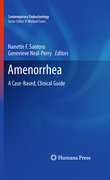
This title draws together worldwide experts who offer the practitioner state-of-the-art, clinically useful information in a reader-friendly fashion and will be a welcome addition to the bookshelves of all physicians who practice in women’s health settings. Chapter one covers the basic physiology of the reproductive axis in women, incorporating the newest information on hypothalamic, pituitary and ovarian signaling. Chapter two details the science of sex steroid responsiveness to estradiol and progesterone and the basic mechanisms responsible for menstrual shedding and its failure to occur on an anatomic basis. Emphasis is placed on the mechanisms by which long term amenorrhea is induced by chronic progestin administration—a common issue encountered in clinical practice. Chapter three then moves into conditions causing amenorrhea and begins with idiopathic hypogonadotropic hypogonadism and hypothalamic amenorrhea (WHO I amenorrhea), introducing these conditions and describing the mechanisms that lead to failure of the hypothalamic pulse generator, using a case based approach.Diagnostic algorithms to guide the clinician are emphasized. Chapter four covers polycystic ovary syndrome, one of the most common endocrinopathies in women. Chapter five is on premature ovarian failure/insufficiency (POF/POI). Chapters six and seven are on prolactin and pituitary causes of amenorrhea and the athletic triad, respectively, with the latter chapter describing the newest scientific findings about the relationship between energy balance and menstrual regularity, offering clinicians a practical approach to the diagnosis and treatment of these problems which are commonly found in physically active adolescents. Chapter eight covers obesity, eating disorders and menstrual disturbancesand chapter nine is on natural and surgical menopause. Chapter ten begins section three of the title and covers long-term clinical implications of amenorrhea, covering the new and emerging data on the chronic nature of many conditions that cause amenorrhea, and its tendency to affect different groups of women differentially, and at different times of life. Chapter ten is on clinical implications of prolonged hypothalamic amenorrhea. Chapter eleven covers long-term implications of hysterectomy with or without oophorectomy and the final chapter, twelve, reviews the issue of ethnicity and amenorrhea, providing an overview of new data that implicate ethnicity as a significant covariate for almostall known types of amenorrhea and also touching on how ethnic disparities in treatment—both surgical and medical—exist and affect outcomes. INDICE: The hypothalamic-pituitary-ovarian axis.- Mechanisms of menstruation and its lack.- Idiopathic hypogonadotropic hypogonadism and hypothalamic amenorrhea (WHO I amenorrhea).- Polycystic ovary syndrome (WHO II amenorrhea).- Premature ovarian failure/insufficiency (POF/POI).- Prolactin and pituitary causes of amenorrhea.- The Athletic Triad.- Obesity, eating disorders and menstrual disturbances.- Natural and surgical menopause.- Clinical implications of prolonged hypothalamic amenorrhea.- Long-term implications of hysterectomy withor without oophorectomy.- Ethnicity and amenorrhea.
- ISBN: 978-1-60327-863-8
- Editorial: Humana
- Encuadernacion: Cartoné
- Páginas: 300
- Fecha Publicación: 29/11/2010
- Nº Volúmenes: 1
- Idioma: Inglés
